Our Verdict
A masterclass in open-world game design and a thrilling samurai epic in its own right, Ghost of Tsushima is a must-play on PC.
Since Sony opened the door to PC ports of some of its first-party titles with Days Gone in 2019, they’ve become a kind of known quantity. Granted, by the time these exclusives make it to PC they’re several years old, but they tend to be beautiful, solidly made open-world games that avoid coloring outside the lines. The PC edition of Ghost of Tsushima, Sucker Punch’s gorgeous samurai stealth-action adventure, continues in this tradition. While hardly revolutionary, it’s nonetheless one of the best uses of the open-world format I’ve ever played, effortlessly pulling off the fusion that Assassin’s Creed has been trying to get right since Origins.
Ghost of Tsushima is set during the Kamakura period, which marked the establishment of the shogunate and the samurai. The open-world game begins as the Mongols arrive in the first wave of their invasion of Japan, and with Tsushima situated about midway between the Japanese main islands and the Korean peninsula, the warlord Khotun Khan identifies it as the ideal place to gain a foothold and prepare for his conquest of the rest of Japan. The local samurai, led by Lord Shimura, meet the Mongols on the beach to repel the attack but are cut down and butchered, and Shimura is taken captive by Khotun, who believes he’ll be a valuable asset for his invasion of the mainland.
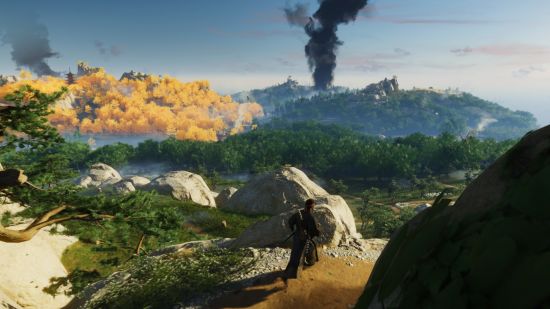
You play as Jin Sakai, a young samurai and the favored nephew of Lord Shimura. Jin survives the massacre on the beach through a combination of dumb luck and the intervention of Yuna, a thief who nurses him back to health in the hopes he’ll help her find her brother, a talented blacksmith also held captive by the Mongol warband.
It’s a terrific setup for a classic samurai cinema yarn, and it’s brought to life by its uncommonly strong cast. The first act has Jin roaming Tsushima’s southern island, assembling a rogue’s gallery of allies to help him assault Castle Kaneda, the imposing fortress where Khotun is holding Shimura captive.
As an open-world game, Ghost of Tsushima will instantly feel familiar to anyone who’s played one of the modern Assassin’s Creed games. The huge map is littered with encounters and activities that individually take only a few minutes to complete – foxes who show you the way to special shrines, hostages who need to be rescued from raiding parties, minor settlements held by bandits. When dealing with enemies, Jin can choose to follow his samurai code by announcing his presence and taking enemies head-on, or he can take the stealthy ‘dishonorable’ route by slinking through the shadows, assassinating unsuspecting foes, and using shinobi tools like smoke bombs and wind chimes to conceal himself.
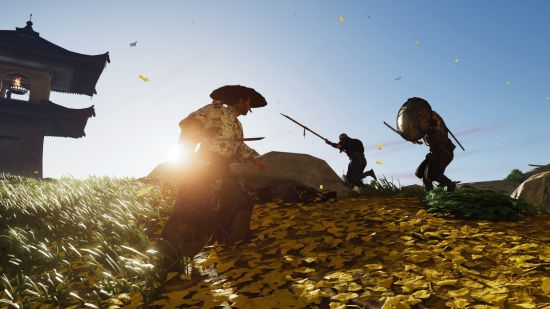
What sets Ghost of Tsushima apart from the rest of the pack is how well each of these individual components is executed. There’s very little fluff in either the story or side quests, which are organized into individual ‘tales’ you can easily keep track of in Jin’s journal. The world itself is vibrant and gorgeous, shifting from forests crowned in brilliant yellow to rolling fields of waving pampas grass. While there’s plenty of room to ride around and explore, it always seems like there’s a new point of interest, another Mongol patrol, or a new story beat just around the next corner.
It’s a thoughtfully designed game that uses environmental design and ambient wildlife to gently suggest directions to explore, keeping you from having to pull up the map too often. You can select a destination, and rather than using a distracting UI element or painted path, the island of Tsushima itself will point you in the right direction via the wind rushing over the hills and through the forests. Spot a golden bird, and you can follow it to something interesting you may otherwise have missed.
Combat is another highlight. Ghost of Tsushima isn’t a punishing game like Nioh 2 or Sekiro: Shadows Die Twice, but fights still feel incredibly dynamic and lethal. Jin can learn several postures that each offer their own unlockable movesets and are particularly effective against certain types of enemies. The stone stance, for example, makes it easier to deal with swordsmen, while the moon stance has special strong attacks that can be used to take out larger brute enemies more efficiently.
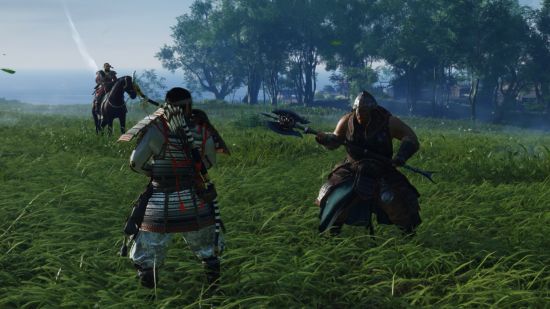
You can switch between these stances on the fly, and use a growing collection of shinobi tools like kunai and smoke bombs as well, but the moment-to-moment excitement of a straight-up sword fight never gets old. The animation for this is all so well done, with enemies ducking when they hear archers calling out their shots, sword blades glancing off shields, and Jin’s graceful dodges all combining into a lethal ballet. I don’t know how historically accurate any of this is, but it looks and feels the way it does in the movies, and that’s fantastic.
While it’s almost always possible to pick off a few isolated enemies before engaging an entire group, Jin can also initiate a standoff any time he encounters hostile soldiers or bandits. This leads to a brief duel, or a game of chicken, with one of the enemy fighters. You hold down a button as you wait for them to commit to an attack, and if you release it at the correct time, Jin flashes forward, slicing up and across his opponent’s body, for an instant kill that shocks and staggers the onlooking gang of mooks and looks incredibly cool every time it happens.
I have to note two of my favorite added flourishes. Before a duel with a key character – Ghost of Tsushima’s boss fights – you’ll see a letterboxed cutscene full of falling leaves and menacing music as the fighters stand off against each other. Each one ends on the scabbard at Jin’s belt, his left hand poised beneath the hilt. Then, after a pause, the slightest movement: Jin flips his thumb out, exposing the first inch or so of blade. The fight begins. Chef’s kiss.
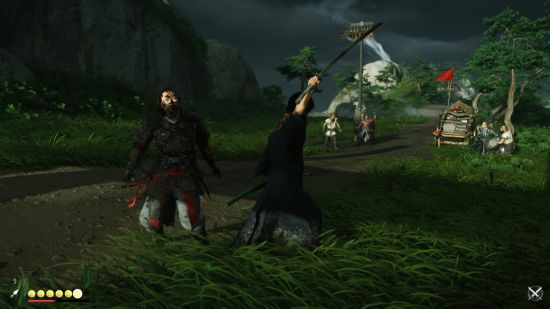
The other is the set of animations for re-sheathing your sword. Jin will put his katana away eventually if it seems like there are no enemies around, but there’s a dedicated command for it too. Trigger it, and Jin will use one of several methods for cleaning his blade before sliding it back into its scabbard. There’s the aggressive one, in which he wipes his blade off along his raised forearm; there’s one where he snaps the blade down and to his side; and there’s one where he simply flips it around in his hands. They’re all badass, and I make a point of deliberately resheathing after each fight.
This new PC edition of Ghost of Tsushima includes dynamic lip sync for Japanese voiceover, which is how I preferred to play. There’s nothing wrong with the English voicework, but in a game so clearly meant to evoke the works of Akira Kurosawa and Masaki Kobayashi, the Japanese performances felt more fitting.
I’ve played using some more of the new features included in the PC edition, specifically its support for ultrawide screen formats, uncapped framerate, and frame generation. Ghost of Tsushima looks phenomenal in ultrawide at 1440p, and performance has been rock solid over the course of the 20 or so hours I’ve played. I’ve encountered only a couple of noteworthy bugs: a shader or lighting issue caused the reflections on a waterfall in Act 1 to completely darken the rest of my screen, but I’ve only seen this happen in that specific location. I also found that the default controller binding for photo mode (tapping right on the D-pad) doesn’t seem to register, and so I’ve had to reach forward to hit P on my keyboard when I want to use it.
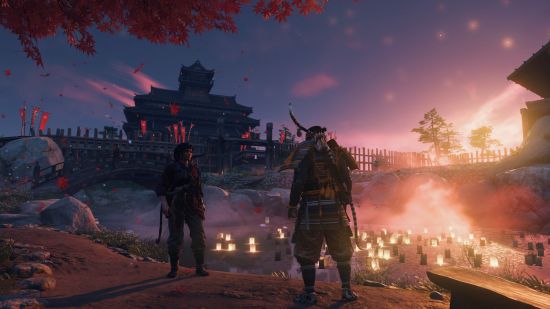
My only other complaints are pretty minor. The PC edition (subtitled the ‘Director’s Cut’) includes both the Iki Island story expansion and the co-op multiplayer Legends mode, which is great. However, Legends mode itself left me a bit cold – it’s thematically very similar to the oni-haunted world of Nioh 2, with reskinned enemies from the core game standing in as the demons. It’s not an objectionable mode by any means, but a couple sessions of it just left me wanting to play Nioh 2 instead.
Ghost of Tsushima is probably as close to the Platonic ideal of the Assassin’s Creed-style open-world game as we can reasonably expect to get. Even tired ideas like multiple lists of collectibles are well implemented here, offering meaningful bite-sized adventures each time you set out looking for them. The map is never cluttered with scores of overlapping ‘go here!’ icons, and the world itself provides so much subtle guidance that you rarely have to pull it out anyway.
I appreciate that, because this painter’s vision of feudal Tsushima is so beautiful that I’m always reluctant to leave.
